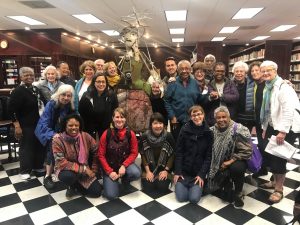History of the Long Trip
Creating ‘Contacts More Real’: Lucy Sprague Mitchell’s Long Trips
When speaking to a group of teacher educators, Lucy Sprague Mitchell (1941) posed two questions: “What can we do to enlarge the groups to which student teachers belong?” and “What can we do to enlarge the groups to which their future school children will belong?” She believed the Long Trip offered an opportunity to move beyond “merely knowing about” people to actually “knowing them.”
In essence, the Long Trip grew from the aims and curriculum of the Bank Street teacher education program, with its focus on the total development of the teacher as well as the child. Based on Deweyan beliefs in education through experience and the social-political aims of education, the Long Trip reflected what Lucy Sprague Mitchell believed was important for teachers: studying children and the world in which children grew—as it was and as it might be.
So each spring, from 1935-1951, excluding the years of World War II when the trips were suspended, Mitchell led the entire class of approximately twenty-five to thirty-five student teachers, all traveling together by bus over a thousand miles, to areas of the country dramatically different from New York City. These week to ten-day trips placed the student teachers in a position to confront directly social and political issues of their day—the labor movement, poverty, conservation, government intervention programs, race relations—all the while considering the lives of children and their families, and the educational implications of what they experienced.
Mitchell (1946) was convinced that “learning that comes from first-hand experience has a smiting quality…” With the optimism characteristic of the progressives, she believed that empathy, caring, and commitment would grow from seeing the world from another’s eye. With the hindsight of over half a century, across years of work and family life, many of the students who attended the Long Trips have confirmed her belief.
– Written by faculty member Sal Vascellaro, GSE ’75



 We saw the Panama Canal in action and learned about the people and the cultures in this country. Our city tour revealed a thriving city with numerous gleaming skyscrapers and evident wealth juxtaposed with older, cramped, decaying buildings: “two different transformation realities!”
We saw the Panama Canal in action and learned about the people and the cultures in this country. Our city tour revealed a thriving city with numerous gleaming skyscrapers and evident wealth juxtaposed with older, cramped, decaying buildings: “two different transformation realities!”